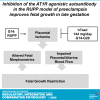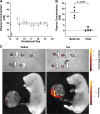Inhibition of the AT1R agonistic autoantibody in a rat model of preeclampsia improves fetal growth in late gestation
- PMID: 36121142
- PMCID: PMC9602704
- DOI: 10.1152/ajpregu.00122.2022
Inhibition of the AT1R agonistic autoantibody in a rat model of preeclampsia improves fetal growth in late gestation
Abstract
Placenta ischemia, the initiating event in preeclampsia (PE), is associated with fetal growth restriction. Inhibition of the agonistic autoantibody against the angiotensin type 1 receptor AT1-AA, using an epitope-binding inhibitory peptide ('n7AAc') attenuates increased blood pressure at gestational day (G)19 in the clinically relevant reduced uterine perfusion pressure (RUPP) model of PE. Thus we tested the hypothesis that maternal administration of 'n7AAc' does not transfer to the fetus, improves uterine blood flow and fetal growth, and attenuates elevated placental expression of miRNAs implicated in PE and FGR. Sham or RUPP surgery was performed at G14 with vehicle or 'n7AAc' (144 µg/day) administered via an osmotic pump from G14 to G20. Maternal plasma levels of the peptide on G20 were 16.28 ± 4.4 nM, and fetal plasma levels were significantly lower at 1.15 ± 1.7 nM (P = 0.0007). The uterine artery resistance index was significantly elevated in RUPP (P < 0.0001) but was not increased in 'n7AAc'-RUPP or 'n7AAc'-Sham versus Sham. A significant reduction in fetal weight at G20 in RUPP (P = 0.003) was not observed in 'n7AAc'-RUPP. Yet, percent survival was reduced in RUPP (P = 0.0007) and 'n7AAc'-RUPP (P < 0.0002). Correlation analysis indicated the reduction in percent survival during gestation was specific to the RUPP (r = 0.5342, P = 0.043) and independent of 'n7AAc'. Placental miR-155 (P = 0.0091) and miR-181a (P = 0.0384) expression was upregulated in RUPP at G20 but was not elevated in 'n7AAc'-RUPP. Collectively, our results suggest that maternal administration of 'n7AAc' does not alter fetal growth in the RUPP implicating its potential as a therapeutic for the treatment of PE.NEW & NOTEWORTHY The seven amino acid inhibitory peptide to the AT1-AA ('n7AAc') has limited transfer to the fetus at gestational day 20, improves uterine blood flow and fetal growth in the reduced uterine perfusion pressure model of preeclampsia (PE), and does not impair fetal survival during gestation in sham-operated or placental ischemic rats. Collectively, these findings suggest that maternal administration of 'n7AAc' as an effective strategy for the treatment of PE is associated with improved outcomes in the fetus.
Keywords: 'n7AAc'; AT1-AA blockade; fetal growth restriction; intrauterine growth restriction; microRNAs; preeclampsia.
Conflict of interest statement
No conflicts of interest, financial or otherwise, are declared by the authors.
Figures







Similar articles
-
Inhibition of angiotensin II type 1 receptor agonistic autoantibodies by direct binding does not impact reduced uterine perfusion pressure offspring birthweight and blood pressure at adulthood.Am J Obstet Gynecol MFM. 2023 Jun;5(6):100945. doi: 10.1016/j.ajogmf.2023.100945. Epub 2023 Mar 27. Am J Obstet Gynecol MFM. 2023. PMID: 36990181 Free PMC article.
-
Blockade of endogenous angiotensin II type I receptor agonistic autoantibody activity improves mitochondrial reactive oxygen species and hypertension in a rat model of preeclampsia.Am J Physiol Regul Integr Comp Physiol. 2020 Feb 1;318(2):R256-R262. doi: 10.1152/ajpregu.00179.2019. Epub 2019 Nov 13. Am J Physiol Regul Integr Comp Physiol. 2020. PMID: 31721604 Free PMC article.
-
AT1-AA (Angiotensin II Type 1 Receptor Agonistic Autoantibody) Blockade Prevents Preeclamptic Symptoms in Placental Ischemic Rats.Hypertension. 2018 May;71(5):886-893. doi: 10.1161/HYPERTENSIONAHA.117.10681. Epub 2018 Mar 19. Hypertension. 2018. PMID: 29555668 Free PMC article.
-
Role of angiotensin II type I receptor agonistic autoantibodies (AT1-AA) in preeclampsia.Curr Opin Pharmacol. 2011 Apr;11(2):175-9. doi: 10.1016/j.coph.2011.01.003. Curr Opin Pharmacol. 2011. PMID: 21317038 Free PMC article. Review.
-
Placenta-targeted Treatment Strategies for Preeclampsia and Fetal Growth Restriction: An Opportunity and Major Challenge.Stem Cell Rev Rep. 2024 Aug;20(6):1501-1511. doi: 10.1007/s12015-024-10739-x. Epub 2024 May 30. Stem Cell Rev Rep. 2024. PMID: 38814409 Free PMC article. Review.
Cited by
-
Role of agonistic autoantibodies to the angiotensin II type 1 receptor (AT1-AA) in pathogenesis of preeclampsia.Glob Med Genet. 2025 Feb 6;12(2):100041. doi: 10.1016/j.gmg.2025.100041. eCollection 2025 Jun. Glob Med Genet. 2025. PMID: 40027241 Free PMC article. Review.
-
Inhibition of angiotensin II type 1 receptor agonistic autoantibodies by direct binding does not impact reduced uterine perfusion pressure offspring birthweight and blood pressure at adulthood.Am J Obstet Gynecol MFM. 2023 Jun;5(6):100945. doi: 10.1016/j.ajogmf.2023.100945. Epub 2023 Mar 27. Am J Obstet Gynecol MFM. 2023. PMID: 36990181 Free PMC article.
-
Growth Restriction in Preeclampsia: Lessons from Animal Models.Curr Opin Physiol. 2023 Apr;32:100647. doi: 10.1016/j.cophys.2023.100647. Epub 2023 Feb 13. Curr Opin Physiol. 2023. PMID: 36968132 Free PMC article.
-
Regulation of vascular angiotensin II type 1 and type 2 receptor and angiotensin-(1-7)/MasR signaling in normal and hypertensive pregnancy.Biochem Pharmacol. 2024 Feb;220:115963. doi: 10.1016/j.bcp.2023.115963. Epub 2023 Dec 5. Biochem Pharmacol. 2024. PMID: 38061417 Free PMC article. Review.
-
AT1-AA Infusion during Pregnancy Impairs CBF Autoregulation Postpartum.Int J Cerebrovasc Dis Stroke. 2023;6(1):154. doi: 10.29011/2688-8734.100154. Epub 2023 Jul 17. Int J Cerebrovasc Dis Stroke. 2023. PMID: 37901747 Free PMC article.
References
-
- Hall JE, Brands MW, Henegar JR. Angiotensin II and long-term arterial pressure regulation: the overriding dominance of the kidney. J Am Soc Nephrol 10, Suppl 12: S258–265, 1999. - PubMed
Publication types
MeSH terms
Substances
Grants and funding
LinkOut - more resources
Full Text Sources
Research Materials
Miscellaneous

